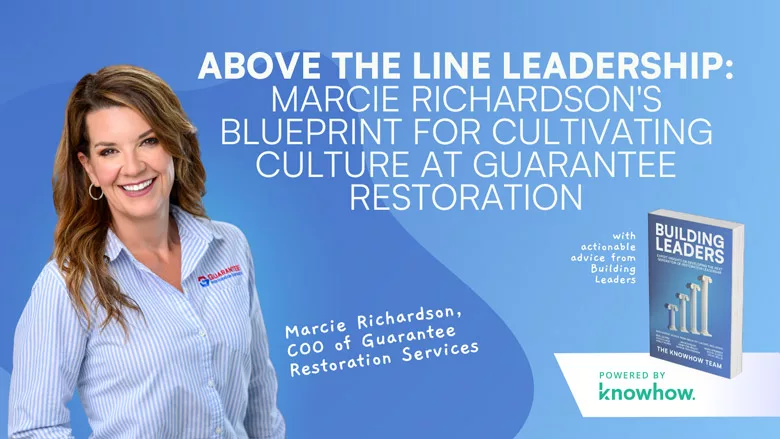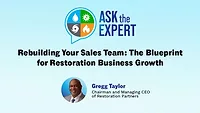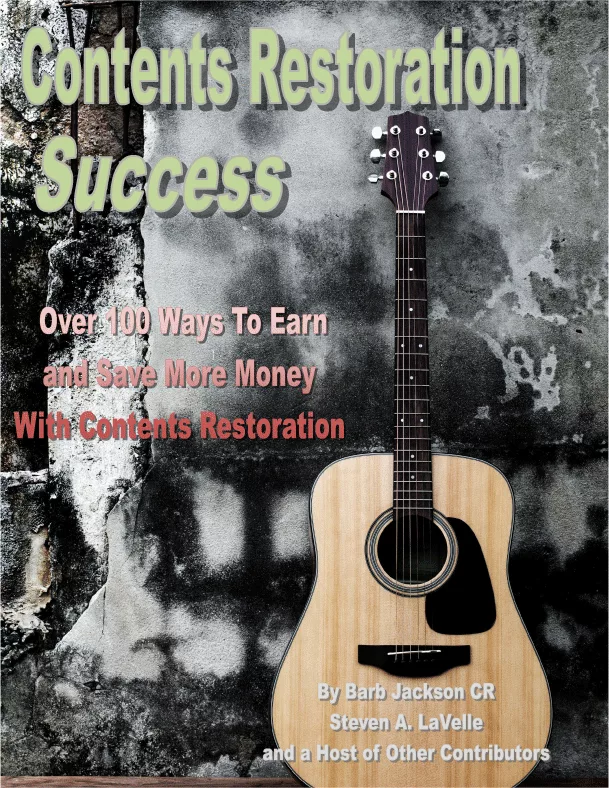Above the Line Leadership: Marcie Richardson's Blueprint for Cultivating Culture at Guarantee Restoration

Image provided by KnowHow.
Welcome back to “Building Leaders,” a brand new series from KnowHow that explores how today’s restoration leaders are setting up their teams for success in the future. Inspired by our latest book, Building Leaders, each interview features in-depth conversations—in text and audio—with industry leaders actively preparing their teams to tackle the leadership challenges of tomorrow.
If you want to stay ahead and ensure your team is ready for tomorrow’s challenges, you’re in the right place. Expect real advice, actionable insights, and plenty of takeaways to help you build a team ready for whatever comes next.
Ready to build the leaders of tomorrow?
The room is quiet.
Around the table, the executive team at Guarantee Restoration Services leans in, eyes turning toward Marcie Richardson, their COO. There are no spreadsheets open. No forecasts to review. No storm prep agenda.
Instead, Marcie opens with a question most leaders might hesitate to ask:
“Are you living out our values this week?”
One by one, the executive team answers. Then comes the harder part—they evaluate each other, openly and without pretense. “You're not showing up as committed today,” one executive tells another. There's no defensive posturing, no carefully masked corporate speak. Just the uncomfortable, necessary truth.
Marcie doesn’t flinch or shame whoever is falling behind. Rather, she follows up with another question: “You're not showing up as a good team member today, so how can we fix that?”
This isn't some corporate trust-building exercise. It’s how Guarantee Restoration keeps its leadership—and wider team—aligned through growth, stress, and high-stakes work.
In an industry where emergencies don't respect nine-to-five boundaries and restoration technicians confront human tragedy daily, Marcie Richardson has helped build a culture that holds.
Her approach is called above-the-line leadership: a system of accountability built on shared language, intentional connection, and trust strong enough to withstand the pressure of the restoration industry.
An Unlikely Restoration Expert
“I got in with Guarantee about six and a half years ago,” Marcie explains. “I've been in HR my entire career, and I was simply filling out some application for the HR manager position with Guarantee.”
She didn’t come from a restoration background. But what she brought was a deep understanding of people and how fast culture can fragment when teams grow.
In Guarantee, she found a company with deep roots. “This is the 50th year we've been in business,” she notes with evident pride. “It started in 1974 with Chunky and Ellen Folks. They started in their apartment as a carpet cleaning outfit, which is what a lot of restoration companies started as.”
Since then, the family business has expanded exponentially. “We've grown to where we are today with six offices across the southeastern United States and 150 employees.”
For Marcie, this growth story wasn't only about square footage or staffing numbers. It was also about something more elusive: how to maintain a cohesive culture when you can no longer fit everyone around a single dinner table. How to ensure that the same values and practices that built the company continue to define it as it scales.
These questions would define her leadership path.
Curious to hear more from Marcie? Click on the video below to catch the full discussion!
The Gardening Framework: Seeding, Watering, Pruning
Marcie doesn't leave culture to chance. She approaches it like a gardener: you seed it, you water it, and you prune it.
“I think [culture] starts from the top down,” she explains. “It starts with our CEO and him speaking the language. If you have to speak what you want to see, you have to like what you're talking about—that's the watering, that's the pruning.”
And then reinforcement has to happen daily, not just during onboarding or annual meetings.
“You have to [reinforce] consciously and intentionally every day, or it's not going to succeed,” Marcie explains.
But effective gardening also demands attentiveness.
“You can't prune if you're not paying attention,” Marcie says. “If you know your employee's good days, you're going to recognize the bad days.”
This attentiveness to small signs is how Marcie ensures that little issues don't balloon into larger problems. By training managers to watch for subtle shifts—in energy, engagement, or performance—she's created an early warning system that maintains the health of Guarantee's culture even as the company expands across state lines.
It’s also how the same values show up consistently across multiple offices. It’s how new hires internalize expectations without reading a manual. And it’s how culture scales, even when the founder isn’t in the room.
A Culture You Can See
If you were to observe Guarantee's culture in its natural habitat, you'd immediately notice something unexpected.
“At first glance, you would see fun. You would see connection,” Marcie says. “You’d walk in and hear the laughter and the jokes.” It's the authentic sound of people who genuinely enjoy working together despite the high-pressure environment.
But peer beneath the surface, and something more substantial emerges. “You would see hard work,” Marcie continues. “One of our values is commitment. And, you know, a lot of times when you're looking at values, you're thinking of outward, but it's also inward. All of our employees are committed to each other, to doing the best that they can so the next person can do their job very well.”
This duality—fun coupled with fierce commitment—doesn't happen by accident. It's cultivated with the precision and attention of a master [culture] gardener.
Maintaining Guarantee’s Culture With Above-the-Line Language
If the gardening framework is what helps culture grow, above-the-line communication is what keeps it strong, especially during stress and disagreement.
Guarantee trains its leaders to coach without shaming. To correct without tearing down. And that starts with shifting the language.
“Below the line approach to me is you shaming,” Marcie says. “You're using negative words, negative emotions, negative tones.”
The alternative is future-focused. “Instead of saying, ‘Hey, you could have done better,’ say, ‘I really appreciate the effort that you put in.’”
That’s what Marcie calls above-the-line communication: a framework for delivering feedback without shame, addressing problems without blame, and leading with clarity instead of fear.
But it’s not just about word choice. Marcie knows that hard conversations fall apart when people feel cornered. So she also trains managers to drop the guardrails.
“Don't put a desk between you and another person. Go take a walk. Go talk somewhere where you're dropping their guard.”
She teaches managers to ask before assuming. To stay curious longer. To prioritize connection over control.
“Ask people questions and get them to open up. The goal is to have that person open up, so having that connection with whoever it is, making sure they're safe and feel comfortable.”
Above-the-line leadership reframes accountability. Instead of creating distance, it builds trust.
“It's okay not to think of where you are today but where you want to go,” Marcie emphasizes. “Today may have been a down point, but if you want to move in the future, think in the future. How do you want to get to your goal?”
Building the Next Generation of Restoration Leaders
Guarantee isn't just growing a business; it's cultivating future leaders through a rhythm as deliberate as the seasons.
Marcie approaches talent development with the same holistic perspective she brings to culture-building. When she looks at her team, she doesn't just see job titles. She sees potential waiting to be unfurled.
“We tell employees, ‘if there's something else—another field that interests you—whether it's in restoration or not, let me know. Because I want to grow you as a person, not just as an employee.”
This isn't corporate altruism. It's strategic gardening.
“I know the better person I build over here, the better the employee I get.”
Her approach gives clear structure without strangling initiative: “A needs to look like Z. B through Y? That's your lane. Figure it out.” It’s not micromanagement but giving people a framework to thrive in without restriction.
This matters especially now, with more generations working together than ever before. “We focus on drawing younger employees in, engaging them, and making sure they're able to step out with confidence.”
But cultivating growth also means knowing when to pause.
“Restoration's a roller coaster,” Marcie acknowledges. “[Restorers] can be gone for three or four weeks at a time, maybe even more.”
Rather than promising an impossible work-life balance, she builds recovery into the system. When work slows down, she encourages longer lunches and early departures. She organizes pre-hurricane season crawfish boils in South Louisiana, creating moments of connection before the storm season.
It's not downtime. It's an intentional pause that makes the next push possible.
“Remember to pause,” she says, revealing her cornerstone principle. “This industry is reactionary. You tend to react quickly to something. Stopping to pause and just gathering myself has benefited me well.”
That pause—the deliberate moment of reflection before response—has transformed from personal practice to a cultural cornerstone that makes Guarantee's growth sustainable even as they navigate constant crises.
It's how you scale people without breaking them, by understanding that the strongest cultures, like the most resilient gardens, grow according to their natural cadence.
What Other Leaders Can Learn From This
If you’re leading through scale, pressure, or constant change, here’s what you can take from Guarantee’s approach:
-
Speak the language you want repeated. Daily. Publicly. Culture forms through consistent reinforcement, not occasional announcements. The words leaders use become the vocabulary of the entire organization.
-
Catch the drooping leaves early. Teach managers to recognize small shifts in engagement or performance before they become major issues. Small corrections early prevent major interventions later.
-
Trade shame for clarity. Accountability works best when people feel safe. Focus conversations on the future rather than dwelling on past mistakes. Remember: “I appreciate your effort” goes further than “you could have done better.”
-
Don't coach behind a desk. Walk, listen, and ask. Connection builds trust. The environment and approach of a difficult conversation matter as much as its content.
- Recognize the season and pause before pushing through. In cyclical businesses, build recovery into your rhythm. The strategic pause isn't wasted time; it's what makes sustained effort possible.
This isn’t just restoration-specific advice. It’s a roadmap for any leader trying to grow without breaking what matters most: your people.
As Marcie has shown, intentional culture-building isn't about grand gestures or perfect conditions. It's about consistent tending, attentive care, and the wisdom to work with, rather than against, the natural seasons of business and life.
For more insights from Marcie Richardson and 13 more restoration leaders, explore our full interview series on YouTube or check out the new audiobook. You should also check out our previous episode with Tony Scott to learn more about how his purpose-driven leadership is transforming the restoration industry.
See you next month for more Building Leaders! For more resources on succession planning or scaling your operation, check out KnowHow.
Looking for a reprint of this article?
From high-res PDFs to custom plaques, order your copy today!








